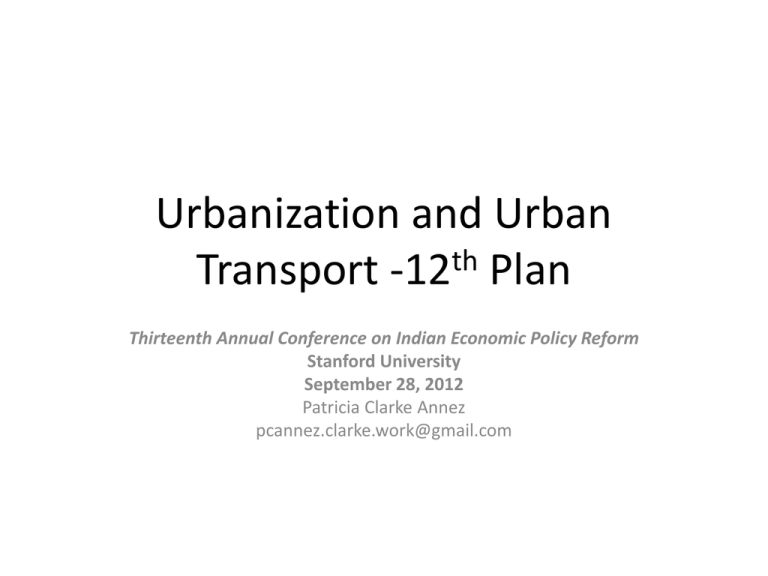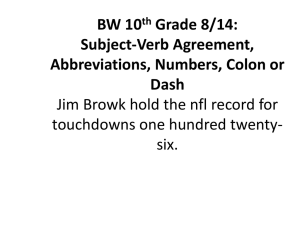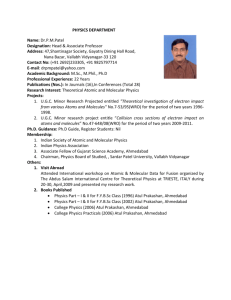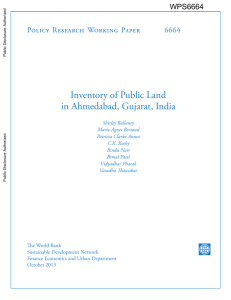Patricia Annez - Stanford Center for International Development (SCID)
advertisement

Urbanization and Urban Transport -12th Plan Thirteenth Annual Conference on Indian Economic Policy Reform Stanford University September 28, 2012 Patricia Clarke Annez pcannez.clarke.work@gmail.com 12th Plan—Much to like • Approach paper has more emphasis on Urban Issues than 11th Plan • Comprehensive quantification of investment requirements • Endorses shift toward Local Solutions and Governance away from top down mandates • Desire to address inefficiencies in land use • Recognizes gaps in urban coverage of plan programs—National Urban Health Mission Some Orders of Magnitude • How relevant for Cities is the traditional Plan model? • Flagship Programs—11th Plan – Generous estimate allocates 17% of project funds to urban areas – JNNURM— the only large urban infrastructure program accounts for 7% of total outlays – JnNURM allocation per annum is about Rs. 250 per capita in cities – HPEC estimates for 12th plan show investment requirements alone of more than 20X that—those are conservative (don’t include land costs, or the additional 50% for maintenance) • For cities—the Plan has to be about more than money and centrally sponsored schemes—and this is recognized in the approach paper • In today’s diverse, faster- growing and private sector oriented economy, the plan should move away from directing investment to improving decisions locally Some Specific Ideas about moving beyond Money • Two key areas where Plan should send the right signals for Urban Policy and Investments – Better Urban land management (public and private) – More information and open access to information- complement strong analytical capacity in India Urban Public Lands-where the money is • HPEC estimates roughly 100,000 Rs per capita today’ s urban population is needed to meet next 20 years of urban investment requirements • Early estimates from a public land inventory in Ahmedabad suggest value of underutilized public land is of equivalent order of magnitude • This land is well situated and valuable for urban economy and transport networks etc. Urban Public Lands Management • • • • • • Who owns it? What is it worth? Where is it? Who is benefitting from allocations? What are rules for disposition? What is value of public land used for subsidizing PPPs?& What is bang for the buck in these barter deals? • How much is under or inappropriately utilized? ( e.g. golf courses on defense lands) None of this is readily knowable now--but could be and needs to be if this asset is to be managed for the broader public good Private Urban Lands—Key Factor of Production in Urban Economy • Regulations prevent intensive use of land in locations market would value • Property rights system impedes private investments and redevelopment of land • Both distortions affect productivity of infrastructure investment • Near absence of relevant economic information stymies policy analysis and impoverishes dialogue –protects rents of beneficiaries of status quo Ahmedabad Built up density map 2001 Ahmedabad—Built Up Densities 1991 2001 Ahmedabad Location of newly built up areas between 2001-2011 Implications for Public Transport • Uniform maximum floor space index strongly distorts density patterns • Density profile appears to be flattening—altho inability to access census 2011 prevents us from updating estimate • As city gets richer, density of built up area is going up—rather than down • Far flung and fragmented suburban development will be difficult to service with public transport esp metro Ahmedabad-Land Development at the Urban Periphery Agricultural Land 11 13 Plot by plot upgrading of tenure Plot by plot grant of NA permission Plot by plot registering of land transaction and levy of stamp duty Plot by plot updating of land cadastre Property by property registration and levy of stamp duty 2 5 Sanction of DP Sanction of TPS 12 1 3 4 6 Zoning of land for development in DP Building city level infrastructure Detailed area planning – TPS Building TPS level infrastructure Plot by Plot development of real estate Building permission Construction monitoring Building use permission 9 14 Purchase of land for development Use of Property Urban DevelopmentDept. 10 Private Sector 8 Dev. Authority/Local Govt. 7 Revenue Dept. Developed Property Ahmedabad—Constraints on Brownfield Investments and Redevelopment • Opaque, uncertain and punitive process makes legal improvements to high value land prohibitively expensive/time consuming etc. • Illegal improvements can’t attract formal finance and are very risky • Result -- land frozen in current use and hh’s unable to invest even if they have capacity to borrow Source: Mahila Housing Trust, Self Employed Women’s Association and Environmental Planning Cooperative Ahmedabad Relevance for Plan Investments • Bad Policies and Dysfunctional property rights system are more costly than ever as purchasing power and demand for well serviced land grows • Ramping up infra spending in this distorted environment will be difficult and wasteful on a large scale • Information poverty gives bad policies staying power • Decentralization and Local government empowerment will not solve this—all three levels of G are needed—and states are on the critical path • Plan should tie resources to addressing these constraints rather than sending down cookie cutter solutions Practical Steps • Rather than vague conditionality like ‘implement decentralization’—relevant published city level information could be mandatory entry level requirement • Creating processes for expedited resolution of property rights disputes • RKVY—rural program encourages States to design programs to meet agreed objectives rather than mandating specific investments – This approach may be more constructive for engaging the States on cities –better than an argument on decentralization which makes an unpopular topic like urban even less appealing politically? – Could also encourage more information gathering and analysis at local level • Evaluation office will help show which projects are working and which are not-could also focus on ‘enabling policy environment’ Thank you!











